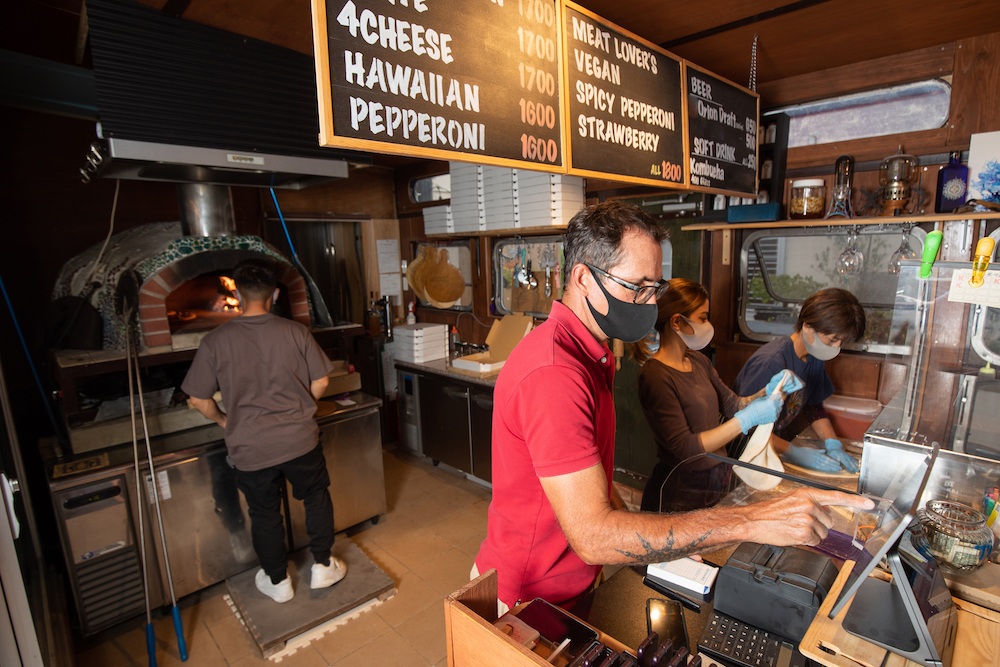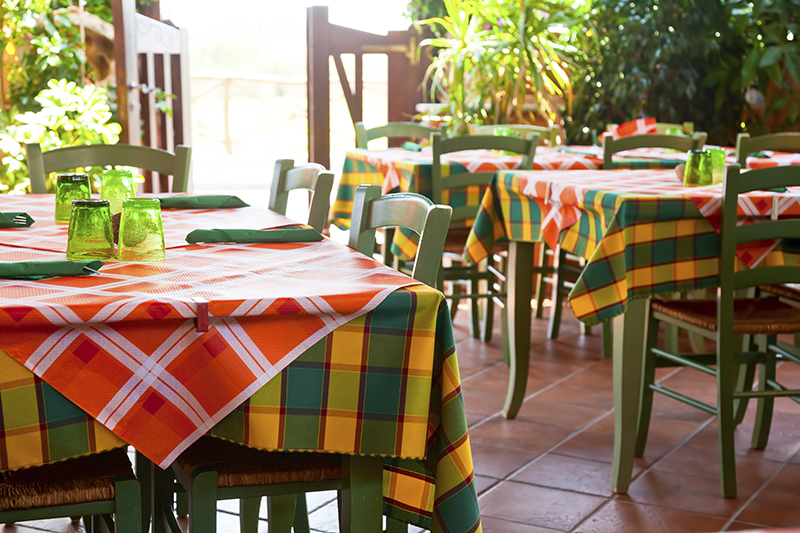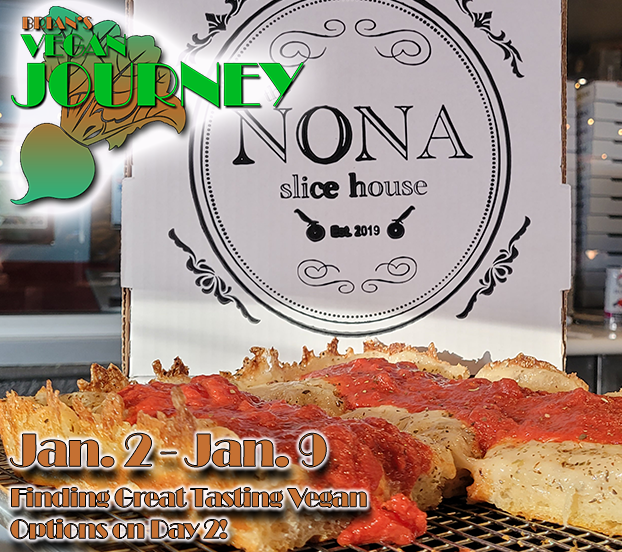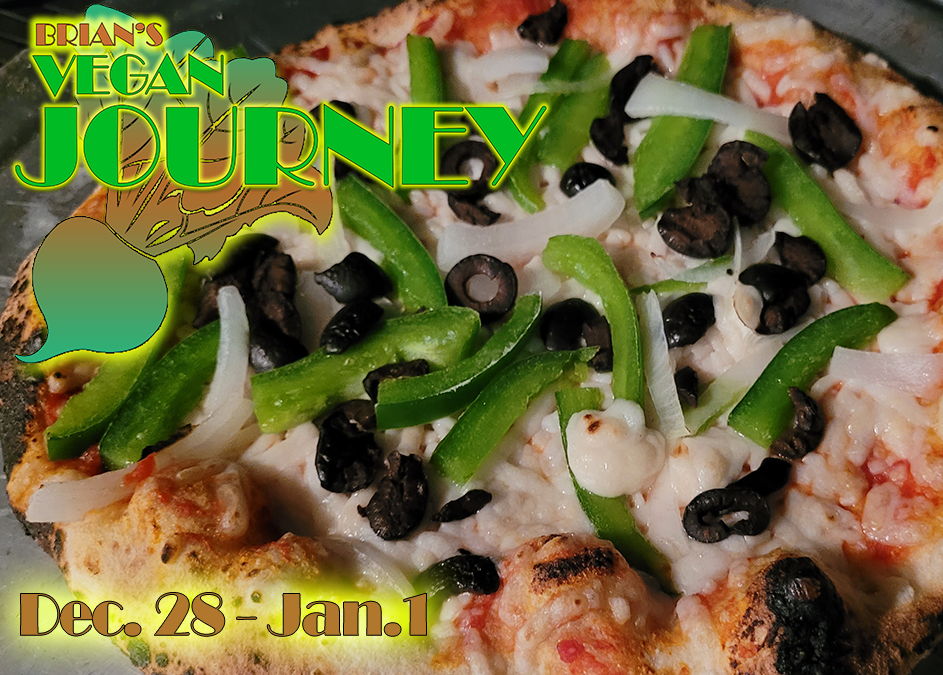While Italians may rightfully claim to be the originators of the dish that we have come to know as pizza, there can be little doubt that the United States has developed the most diverse expressions of this culinary mainstay. This is a result of many factors, including cross-cultural influences, creativity, and the vast array of ingredients and equipment available to ambitious America-based pizza chefs. Unlike classic French cuisine, the rustic Italian cooking arts that inspired American pizza are highly regionalized and resistant to rigid structure and rules. Students of the pizza making craft have felt free to experiment and innovate so that in the United States we now have dozens of identifiable pizza making styles often coexisting side by side.
Because my restaurants are located in Las Vegas, which has residents and visitors from all over the world, we feature several different types of pizza that are representative of diverse techniques and preferences. The ability of pizza to absorb and adapt to social, cultural and historical influences has allowed it to thrive in changing marketplaces and find a place on menus throughout the world.
Some chefs would claim that there are as many pizza styles as there are people who make them. However, in the United States, the dominant popular forms can be identified by some basic key elements, including dough type, stretching and shaping method, sauce and spice profile, cooking methods and topping variations. In the past, most of the variations could be found only in their places of origin; however, in the modern era, each of the styles has adherents throughout the country.
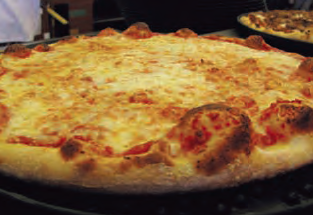 New York Style (modern) features a classic thin crust. New York-style pizza remains the most popular form in the country. The basic dough uses high-gluten bromated flour,
New York Style (modern) features a classic thin crust. New York-style pizza remains the most popular form in the country. The basic dough uses high-gluten bromated flour,
milled from wheat primarily grown in North Dakota and Minnesota. Fresh yeast is used, and long fermentation times are employed to create flavor and texture. Olive oil is added for enhanced flavor and to prevent the sauce from penetrating the dough. This pizza is always hand-stretched to order, with a minimum size of 16” in diameter and a pronounced rim. The smooth, thin tomato sauce is made from sweet, vineripened California tomatoes and can be seasoned with oregano and occasionally thyme. High-butterfat, low-moisture shredded mozzarella cheese from Wisconsin is preferred, and an additional light sprinkle of imported Romano cheese may be added after the pizza is baked. Typically, this pizza will be cooked directly on the stones of a gas-fired oven, with many pizza makers claiming that older stones are superior.
New Haven Style is loosely based on the pizza of Naples. Local residents use a dialect-based pronunciation, always referring to this type as “ah-beetz.” The dough recipe for this pizza uses medium-protein all-purpose flour and a high percentage of water. This formulation results in loose dough that is hand-stretched on a marble table. The dough is usually too soft to pick up and is simply flipped onto the pizza paddle before being slid into a coal-fired oven, which produces a crispy yet tender crust. Typically, these pizzas are irregular in shape and distinctively charred. The sauce is similar to the New York style but may include fresh garlic. Cheese can be a combination of low-moisture mozzarella and New England cheddar; however, these pizzas tend to use light amounts of cheese. New Haven is famous for the clam pizza, which uses only olive oil, garlic, fresh clams and oregano without any form of cheese.
Mountain or Western Style has been influenced by the climate and active lifestyle of its residents. Dough is formed using warm water and fast-acting yeast. Often, whey or milk will be added for mildly sweet dough, or recipes will include sourdough starter. Crust is medium to thick, with a pronounced rolled edge. Pizza is topped with a relatively light amount of thick, tangy sauce that is seasoned with oregano, thyme, dry basil, marjoram and granulated garlic. Pizzas are covered with large amounts of part-skim California mozzarella cheese, sometimes mixed with yellow cheddar. Pepperoni is the most common topping, but more exotic local ingredients may be added, such as ground American bison meat. Pizzas are baked on wire racks in conveyor ovens and are usually cooked lightly with no distinct charring or blistering. In colder climates, this pizza will be served with a side order of honey for dipping the remaining crust at the completion of the meal.
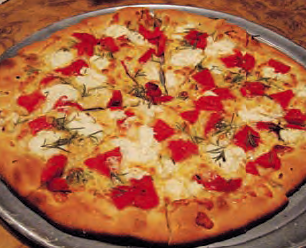 Southern New Jersey-Style Tomato Pie, on the surface, appears similar to the New York style; however, there are several distinct differences. Typically, dough formulation will not include olive oil. While the hand-stretching method is done as in the New York style, this pizza is topped with locally produced shredded mozzarella before the sauce is applied. Sauce is smooth but thicker than New York-style sauce and is splashed on the pizza randomly, with Romano or domestic Parmesan cheese added on top. The “cheese first” method produces a crispier crust with creamier melted cheese. Traditional toppings are anchovies, or sliced sausage that is precooked and then distributed on the pizza before baking.
Southern New Jersey-Style Tomato Pie, on the surface, appears similar to the New York style; however, there are several distinct differences. Typically, dough formulation will not include olive oil. While the hand-stretching method is done as in the New York style, this pizza is topped with locally produced shredded mozzarella before the sauce is applied. Sauce is smooth but thicker than New York-style sauce and is splashed on the pizza randomly, with Romano or domestic Parmesan cheese added on top. The “cheese first” method produces a crispier crust with creamier melted cheese. Traditional toppings are anchovies, or sliced sausage that is precooked and then distributed on the pizza before baking.
Chicago-Style Thin Crust is sometimes referred to as “tavern pizza.” Dough is made from all-purpose flour, and contains low water content and a high percentage of vegetable oil. Fast-acting dry yeast is preferred with short fermentation times. Dough is never hand-stretched, but is instead rolled out in advance using a rolling pin or a mechanical dough sheeter in high-volume restaurants. This method produces a flat, tight crust with no raised edges. Pizzas are topped with a tangy, thick tomato paste that has been heavily seasoned with oregano and granulated garlic. All toppings are placed under the shredded mozzarella cheese. Raw sausage that has been removed from the casing is the most common topping. Pizzas are baked in a rotating or carousel deck oven at relatively low temperatures. This method produces a crackerlike crust. Pizza is cut in small squares before serving.
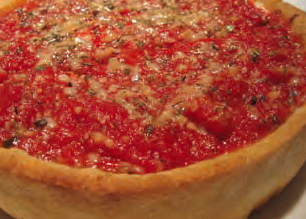 Chicago-Style Deep Dish is often considered a Chicago creation, but it’s actually a variation of the savory holiday pies first introduced to Southern Italy by Albanian refugees in the 15th century. The rich biscuitlike texture of the crust is achieved by using winter wheat flour from the Midwestern United States mixed with a high percentage of shortening and sometimes aided by the inclusion of cornmeal or semolina. A small amount of beer may be included in the mix to create more complex flavors and aroma. Dough is pressed into heavy, high-sided, black steel pans that have been coated with oil, shortening or butter. This pizza gives the appearance of having a thick crust because the dough has been shaped up the side of the pan; however, it should not be confused with thick-crust pizza. Dough is allowed to rest in the pan for 15 minutes or more and then is filled with layers of mozzarella, toppings, and a covering of smooth or crushed tomato sauce that is seasoned with oregano and domestic Parmesan and sprinkled with olive oil. The most common toppings include fennel-flavored sausage, pepperoni and cooked spinach that has been seasoned with nutmeg. Pizzas are baked in deck or carousel ovens at 425° for up to 45 minutes.
Chicago-Style Deep Dish is often considered a Chicago creation, but it’s actually a variation of the savory holiday pies first introduced to Southern Italy by Albanian refugees in the 15th century. The rich biscuitlike texture of the crust is achieved by using winter wheat flour from the Midwestern United States mixed with a high percentage of shortening and sometimes aided by the inclusion of cornmeal or semolina. A small amount of beer may be included in the mix to create more complex flavors and aroma. Dough is pressed into heavy, high-sided, black steel pans that have been coated with oil, shortening or butter. This pizza gives the appearance of having a thick crust because the dough has been shaped up the side of the pan; however, it should not be confused with thick-crust pizza. Dough is allowed to rest in the pan for 15 minutes or more and then is filled with layers of mozzarella, toppings, and a covering of smooth or crushed tomato sauce that is seasoned with oregano and domestic Parmesan and sprinkled with olive oil. The most common toppings include fennel-flavored sausage, pepperoni and cooked spinach that has been seasoned with nutmeg. Pizzas are baked in deck or carousel ovens at 425° for up to 45 minutes.
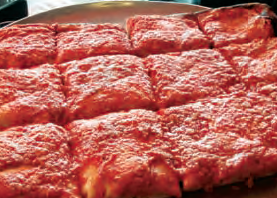 Philadelphia-Style Tomato Pie is similar in name to the New Jersey pizza, but this type is actually quite different. Dough is made from all-purpose flour, allowed to ferment, and then stretched and placed in a square black steel pan that is coated with olive oil, or baked directly on the stones of an oil-fired oven. A light sprinkle of shredded mozzarella is generously covered by a chunky slow-simmered tomato sauce that contains yellow onion, fresh garlic and a large amount of extra-virgin olive oil. The pizza is topped with grated Parmigiano-Reggiano before baking.
Philadelphia-Style Tomato Pie is similar in name to the New Jersey pizza, but this type is actually quite different. Dough is made from all-purpose flour, allowed to ferment, and then stretched and placed in a square black steel pan that is coated with olive oil, or baked directly on the stones of an oil-fired oven. A light sprinkle of shredded mozzarella is generously covered by a chunky slow-simmered tomato sauce that contains yellow onion, fresh garlic and a large amount of extra-virgin olive oil. The pizza is topped with grated Parmigiano-Reggiano before baking.
California Style (modern) was developed in the 1980s, though there has been pizza in California since the first Italian immigrants arrived in the 19th century. In the last 25 years, the infl uence and innovation of California-based chefs have revolutionized American cooking trends. Organic, locally grown ingredients combined with the fusion of Asian and classic European techniques have inspired a new “Golden Age” in pizza baking. Typical dough formulas will use organic unbleached bread flour, often combined with honey or sugar to produce a chewy, pliable crust. Pizzas are hand-stretched with a pronounced rim and do not exceed 12” in diameter. Woodfired ovens, often using aromatic woods such as mesquite or hickory, are preferred, but gas-fired open-flame brick ovens will be used when local ordinances prohibit the burning of wood. Toppings are selected in accordance with seasonal availability. Noticeable Asian influence can be seen in the use of fresh lightly cooked vegetables that retain beautiful color and texture. Great emphasis is placed on the balance of fl avors and texture. A wide variety of locally produced artisan cheeses are employed in combination, including cow, sheep and goat milk cheeses.
And then you have the two most recently resurrected forms:
 “Authentic” Neapolitan Style is gaining in popularity but is not without controversy.
“Authentic” Neapolitan Style is gaining in popularity but is not without controversy.
Some pizza makers view the rules and criteria established by self-appointed organizations to be confining and created more with the intent of selling Italian products and equipment than with producing the best-quality pizzas. On the other hand, a properly made Neapolitan
style pizza is truly delicious and an exercise in culinary simplicity and restraint. Dough consists of Italian “00” flour combined with only water, sea salt and fresh yeast; no other ingredients are allowed. Gentle mixing is followed by varying lengths of fermentation, with longer times currently in favor. Dough is carefully hand-stretched to no more than 12” in diameter with a pronounced cornicione, or edge, that becomes well-blistered when baked. Tomato sauce is thin and consists only of vine-ripened San Marzano tomatoes from Campania that have been passed through a food mill. Cheese must be fresh sliced mozzarella from the area surrounding Naples but can be made from either cow or water buffalo curd. Fresh basil is applied either under the cheese or after the pizza has baked. Pizza may be finished with a light sprinkle of sea salt, Parmigiano-Reggiano and olive oil. The pizza must be baked in a wood-fired oven using nonaromatic wood. The oven must be manufactured in Italy or assembled by Italian artisans from Italian materials. In the past, this pizza was limited to four varieties, but in modern times seasonal and regional toppings are common, and it is not unusual for an Italian pizza maker to have as many as 200 different combinations in his repertoire.
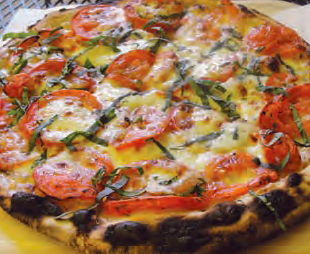 “Old New York” Coal Oven-Style Pizza (pictured right) has recently been recognized as an emerging trend in the United States. It is often marketed as the original style of Italian-American pizza, although this claim is highly debatable. Origins aside, this method can certainly produce unique and delicious pizzas. Dough is made from American high-gluten flour, water, salt and fresh yeast. Early Italian immigrants to the United States were amazed at the variety of flours available and developed recipes to take advantage of this abundance. Pizzas are thin and hand-stretched, with a small raised edge that becomes very charred and blistered from the intense heat of the oven. Sauce is made from crushed San Marzano tomatoes, and each pizza is individually seasoned with oregano and Romano cheese. Pizzas are topped with thin slices of cow-milk mozzarella from New York State that is specially formulated with slightly lower moisture content than traditional buffalo mozzarella or fi or di latte. Raw vegetables are never placed on these pizzas; instead, most toppings are preroasted in the coal ovens before being added. Hand-sliced pepperoni with a high fat content is prized for its tendency to char, cup and release flavorful oils on the pizza. The baking time for coal-fired pizza can be as short as 90 to 120 seconds. Unlike modern New York pizza, this type is rarely sold by the slice, and the pizzas never exceed 18” in diameter.
“Old New York” Coal Oven-Style Pizza (pictured right) has recently been recognized as an emerging trend in the United States. It is often marketed as the original style of Italian-American pizza, although this claim is highly debatable. Origins aside, this method can certainly produce unique and delicious pizzas. Dough is made from American high-gluten flour, water, salt and fresh yeast. Early Italian immigrants to the United States were amazed at the variety of flours available and developed recipes to take advantage of this abundance. Pizzas are thin and hand-stretched, with a small raised edge that becomes very charred and blistered from the intense heat of the oven. Sauce is made from crushed San Marzano tomatoes, and each pizza is individually seasoned with oregano and Romano cheese. Pizzas are topped with thin slices of cow-milk mozzarella from New York State that is specially formulated with slightly lower moisture content than traditional buffalo mozzarella or fi or di latte. Raw vegetables are never placed on these pizzas; instead, most toppings are preroasted in the coal ovens before being added. Hand-sliced pepperoni with a high fat content is prized for its tendency to char, cup and release flavorful oils on the pizza. The baking time for coal-fired pizza can be as short as 90 to 120 seconds. Unlike modern New York pizza, this type is rarely sold by the slice, and the pizzas never exceed 18” in diameter.
By becoming familiar with all of the existing types, you can add your own experiences and originality, transcending the current forms and adding to the larger body of pizza knowledge for the next generation of pizza makers and pizza eaters.




